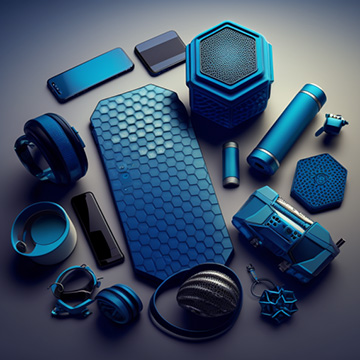
[Image: Graphenest]
Graphenest, an early-stage nanotechnology company based in Sever do Vouga, Portugal, has unveiled a strategic partnership with the Manchester, UK–based polymer-masterbatch manufacturing company Hubron International to commercialize graphene-based polymers. The partnership’s first effort will focus on developing graphene-based polymer compounds for microwave- and millimeter-wave shielding for 5G and 6G technologies.
Graphene-based EMI shielding
Graphenest’s primary activity is developing sustainable graphene-based coatings and shielding solutions for electromagnetic interference (EMI), targeted especially to the automotive and electronics sectors. The company hopes to replace the current generation of heavy, rigid and energy-intensive metal-based shielding systems with “cost-effective, ultralightweight and sustainable conductive coatings and plastic systems.”
In pairing up with Hubron International, Graphenest hopes to benefit from Hubron’s expertise in masterbatch, a formulation in which a polymer’s properties are changed through the addition of solid additives encapsulated in a carrier material. While often used for coloration, masterbatch can also be used to impart other properties to a given plastic.
In a press release, Hubron was described as “a leading global specialist in masterbatch,” with experience in creating a variety of specialist grades, including “additive masterbatches with graphene, graphite and other materials to improve end-product properties and performance.” Hubron’s first experiments with graphene were in 2014, but the company “saw the first real volume [of graphene] go through our plant” in 2020, the company’s technical manager, Robert Laurent, said in a June 2021 interview.
Bruno Figueiredo, the co-CEO of Graphenest, argued that lightweight, graphene-based polymer EMI shielding of microwave and millimeter-wave radiation “will be crucial in the near future.” He suggested that such shielding was finding increased interest, “mostly because more electronics and e-mobility devices are linking to one another. As a result, we can no longer completely rely on traditional, unsustainable metals.”
Edging toward commercialization
Perhaps the archetypal 2D material, graphene—atom-thin sheets of carbon, whose discovery and elucidation captured the 2010 Nobel Prize in Physics—has long been touted for commercial prospects, owing to its exceptional mechanical strength, electrical conductivity, optical transparency and other properties.
Yet actual commercialization has been slow in coming. In large part that’s attributable to the difficulty of creating defect-free graphene at scale. As those problems have gradually begun to be solved, commercial applications have started to emerge in niches such as sporting goods and specialty coatings.

[Image: Graphene Flagship]
The announcement of the Graphenest–Hubron partnership came via the Graphene Flagship, a €1 billion (US$1.1 billion), 10-year effort begun in October 2013 and maintained under the European Union’s Horizon 2020 funding framework program. The flagship program is an academic-industry partnership aimed specifically at helping to move graphene technology from the lab to the commercial sphere. Graphenest has been a member of the Graphene Flagship consortium since 2017.
